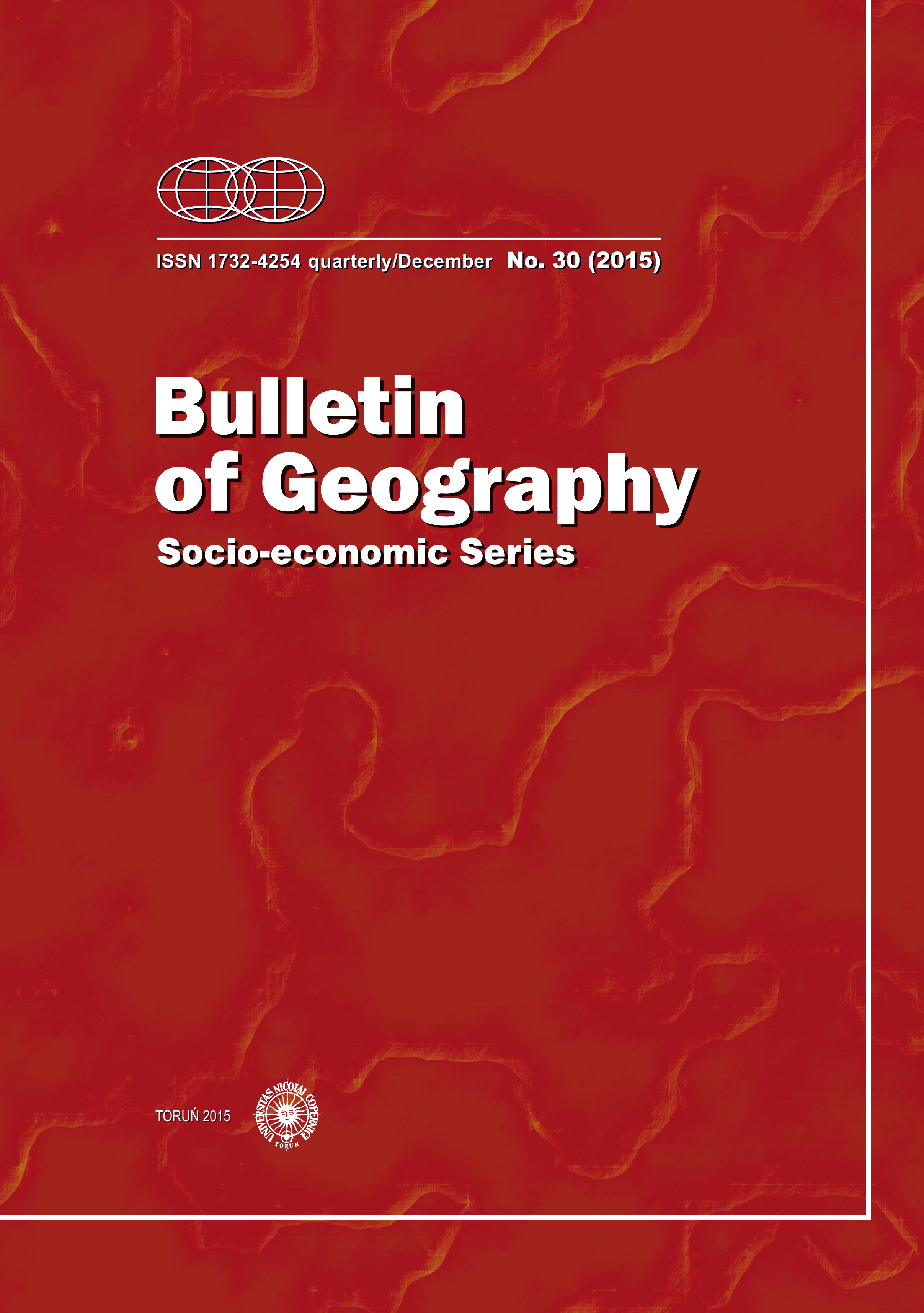Spatial hierarchy and emerging typologies inside world city network
DOI:
https://doi.org/10.1515/bog-2015-0032Keywords
world city, global city, globalization, urbanization, urban hierarchyAbstract
The first part of the paper provides a new approach to measuring a spatial structure of world city network (WCN). Based upon the results of media- popular ‘global city rankings’ produced by several international think tanks, our calculation allowed to reveal global urban hierarchy and identify several subnetworks inside of world cities. The second part of the paper devotes to recent discussions on nature of globalization and urban macrosystems, bearing in mind ranking results. It is shown that a typological approach can provide more insights to a role of city as part of WCN from functional and relationships prospective.
References
Alderson, A. S., Beckfield, J. and Sprague-Jones, J., 2010: Intercity Relations and Globalisation: The Evolution of the Global Urban Hierarchy, 1981-2007. In: Urban Studies,Vol. 47(9), pp. 1899-1923. DOI: 10.1177/0042098010372679
Chubarov, I. and Brooker, D., 2013: Multiple pathways to global city formation: A functional approach and review of recent evidence in China. In: Cities, Vol. 35 (0), pp. 181-189. DOI:10.1016/j.cities.2013.05.008
Chubarov, I. and Sluka, N., 2012: The largest agglomerations of China within a system of global cities. In: Vestnik Moskovskogo Universiteta, Seriya 5: Geografiya, Vol 2, pp. 32-39
Clark, G. Globalnaya Moskva (Global Moscow - in Russian). In: Vedomosti. 24.02.2012 Available at: http:// www.vedomosti.ru/opinion/articles/2012/02/24/ globalnaya_moskva , DoA: 01.06.2015
Cook, I., 2006: Beijing: An ‘internationalized metropolis. In: Wu, F. editor, Globalisation and the Chinese city, London: Routledge. pp. 63-84.
Derudder, B., 2006: On Conceptual Confusion in Empirical Analyses of a Transnational Urban Network. In: Urban Studies. Vol. 43 (11). pp. 2027-2046, DOI: 10.1080/00420980600897842
Friedmann, J., 1986: The World City Hypothesis. In: Development and Change, Vol. 17(1), pp. 69-84. DOI: 10.1111/j.1467-7660.1986.tb00231.x
Friedman, T., 2005: The World is Flat: A Brief History of Twenty-First Century, Farrar: Straus and Giroux. GaWC, 2000, 2004, 2008, 2010, 2012: The World According to GaWC. Available at: http://www.lboro.ac.uk/ gawc/gawcworlds.html , DoA: 01.06.2015
Gugler, J., 2004: World cities beyond the West: globalisation, development, and inequality, Cambridge: Cambridge University Press. DOI: 10.1177/030913250703 10041102
Hall, P.M., 1966: The world cities, London: Weidenfeld & Nicolson Publishing.
Hill, R.C. and Kim, J.W., 2000: Global cities and development states: New York, Tokyo and Seoul. In: Urban Studies, Vol. 37(12), pp. 2167-219. DOI: 10.1080/00420980020002760
Jones, A., 2010:Globalization: key thinkers, Cambridge: Polity Press. DOI: 10.1177/0268580910391018
Kearney, A.T., 2012: Global cities index and emerging cities outlook. Available at: https://www.atkearney. com/research-studies/global-cities-index/2012. DoA: 01.06.2015
Knight, F., 2014: Global cities index.In: The Wealth Report. Available at: https://www.privatebank.citibank. com/announce/The_Wealth_Report_2011LowRes.pdf , DoA: 01.06.2015
Kratke, S., 2014: How manufacturing industries connect cities across the world: extending research on ‘multiple globalisation’. In: Global Networks, Vol. 14 (2), pp. 121-147. DOI: 10.1111/glob.12036
Kurasov, A.V., 2009: Formirovanie globalnyh gorodov v raznyh geograficheskih usloviyah (Global cities formation under different geographical conditions - in Russian), Moscow: RAS Institute of Geography PhD Thesis Manuscript.
Ma, X. and Timberlake, M., 2008: Identifying China’s leading world city: a network approach. In: GeoJournal, Vol. 71, pp. 19-35. DOI: 10.1007/s10708-008- 9146-8
Ma, X. and Timberlake, M., 2013: World City Typologies and National City System Deterritorialisation: USA, China and Japan. In: Urban Studies, Vol. 50 (2), pp. 255-275. DOI: 10.1177/0042098012453859
Matthiessen, C.W., Schwarz, A.W. and Find, S., 2010: World cities of scientific knowledge: systems, networks and potential dynamics. An analysis based on bibliometric indicators. In: Urban Studies, Vol. 47(9), pp. 1879–1897. DOI: 10.1177/0042098010372683 Mori Memorial Foundation, 2012: Global Power City Index 2012. Tokyo. Available at: http://www. mori-m-foundation.or.jp/english/research/project/6/ gpci2012.shtml , DoA: 01.06.2015
Olds, K. and Yeung, H.W.C., 2004: Pathway to global city formation: a view from developmental city-state of Singapore. In: Review of International Political Economy, Vol. 11(3), pp. 489-521. DOI: 10.1080/096 9229042000252873 PWC, Partnership for New York City, 2012: Cities of Opportunity. Available at: http://www.pwc.com/us/en/ cities-of-opportunity/, DoA: 01.06.2015
Sassen, S., 1991, 2001: The global city: New York, London, Tokyo, Princeton, N.J: Princeton University Press.
Taylor, P., Ni, P., Derudder, B., Hoyler, M., Huang, J. Witlox, F., Yang, X., Bassens, D. and Shen, W., 2009: Measuring the world city network: new developments and results. GaWC Research Bulletin 300.Available at http://www.lboro.ac.uk/gawc/rb/rb300.html , DoA: 01.06.2015
The Economist Intelligence Unit, 2012: Hot Spots. Benchmarking global city competitiveness. Available at: http://www.economistinsights.com/sites/default/ files/downloads/Hot%20Spots.pdf, DoA: 01.06.2015
Verhetsel, A. and Sel, S., 2009: World maritime cities: From which cities do container shipping companies make decisions? In: Transport Policy, Vol. 16 (5), pp. 240-250. DOI: 10.1016/j.tranpol. 2009.08.002 © 2015
Downloads
Published
How to Cite
Issue
Section
License
Title, logo and layout of journal Bulletin of Geography. Socio-economic Series are reserved trademarks of Bulletin of Geography. Socio-economic Series.Stats
Number of views and downloads: 477
Number of citations: 1



